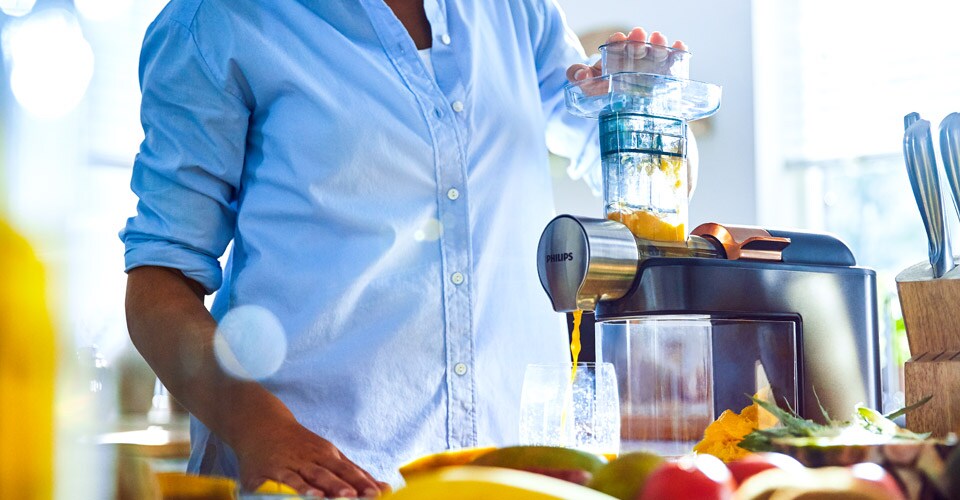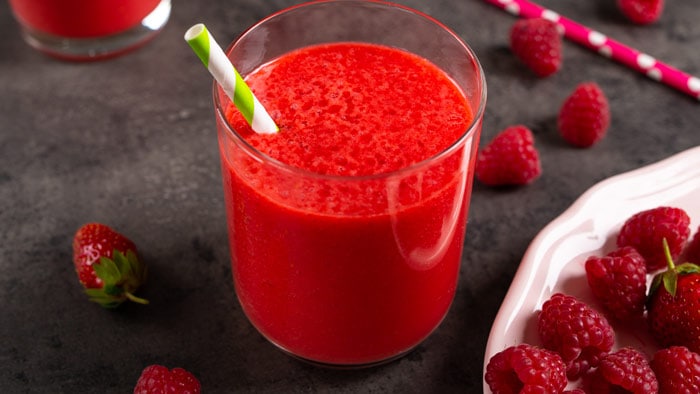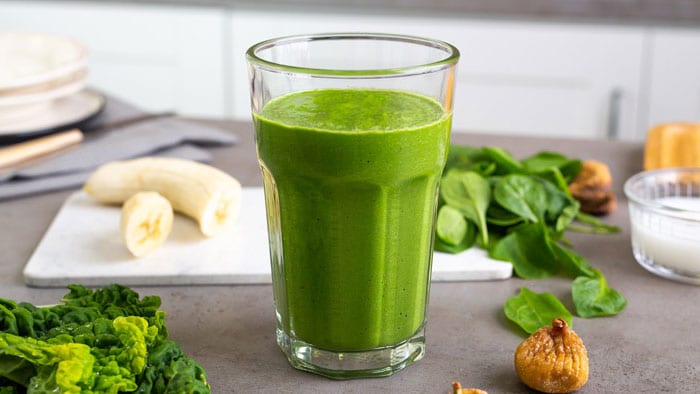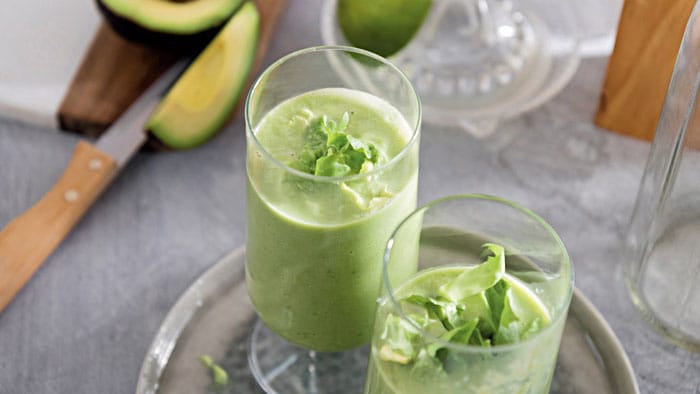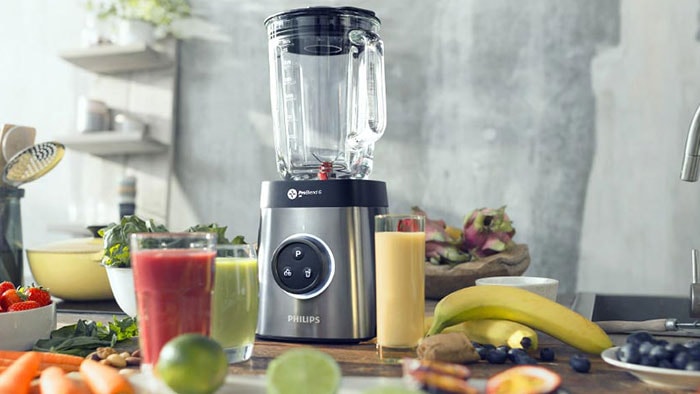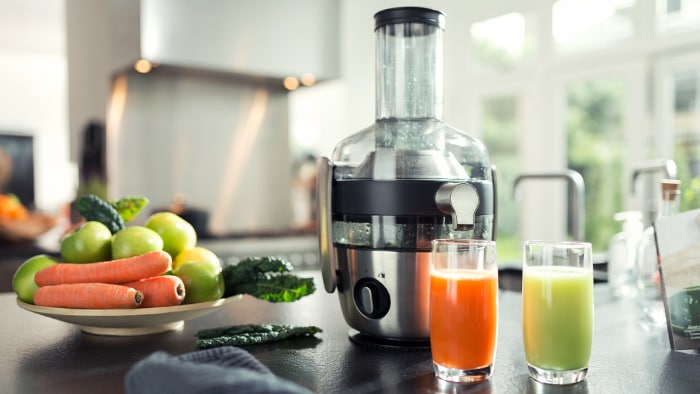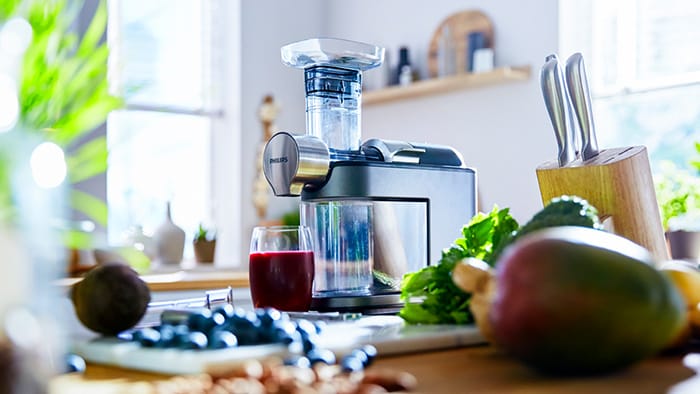Reading time: 5 Min
How to Pick the Best Juicer for You: A Guide to Different Types of Juicers
We all love a glass of fresh juice when we get up in the morning or get back from exercising. They taste great and the health benefits are second to none.
Read on to find out about the features and benefits of different juicer types available to buy and how to choose the right type of juicer for your home.
What Is the Best Juicer for Me?
The best juicer for your home is one that can fit around the needs of your family and the space in your kitchen.
There are three main types of kitchen equipment you can use to make healthy drinks like fruit and vegetable juices at home:
- Masticating juicer
- Centrifugal juicer
- Blender
First, let’s look at how juicers and blenders work.
Juicer vs. Blender: What’s the Difference?
The biggest differences between a juicer and a blender are how they process ingredients and “pulp”.
Pulp is the fibrous part of fruit and veg that’s left behind after you’ve got the juice out.
Juicers extract the concentrated juice and leave behind the pulp. This means you get a clear, thin and nutrient-packed healthy drink.
Blenders process and blend all the ingredients together, including the pulp.
That makes them great for thick drinks like smoothies. Chefs love them too for the types of sauces they can make with a blender.
Masticating vs. Centrifugal Juicers
If it’s smooth juice you want, juicers are better. Now your choice is between a centrifugal or masticating juicer.
What is a masticating juicer?
A masticating juicer extracts juice by forcing fruit and vegetables against and through a mesh at 80 to 100 RPM into a jug or glass using an auger. They’re sometimes called “slow juicers”.
The spiral-shaped auger crushes and squeezes the fruit and vegetables you feed into the machine to extract juice.
Masticating juicers are popular because they’re great at making high-quality nutrient-rich juices.
They also minimise heat and oxidation when in operation which preserves the vitamins, minerals, and enzymes in your juice.
The pros of a masticating juicer
- Process more food types: They are the best greens juicer, able to process leafy greens, wheatgrass, nuts, and seeds – so you can whip up nut milks and more.
- Get greater yields: These types of juicers have a higher juice yield meaning you get more juice for the same amount of produce.
- Perfect for summer fruits: They’re great for creating fresh summer juices with small, in-season fruits such as raspberries and strawberries.
The cons of a masticating juicer
- Needs prep work: On masticating juicers with smaller feeding tubes, you’ll have to cut up larger items of fruit and veg before you feed them into the machine.
- Cleaning time: They can be hard to clean as they have more fiddly bits and require more effort to assemble and disassemble for thorough maintenance.
- Takes longer: Masticating juicers are slower and take more time to extract the juice which can be a drawback if you’re in a hurry.
What is a cold press juicer?
Some people refer to masticating juicers as “cold press juicers” but this is actually a mistake.
Cold press juicers actually extract juice in a completely different way.
Instead of crushing and pulping fruit and veg with an auger and pushing it through a mesh, cold press juicers use a hydraulic press or similar tool to squeeze the juice out of pre-prepared produce.
Juice from cold press juicers has less pulp, more nutrients and is generally smoother.
What is a centrifugal juicer?
Centrifugal juicers extract the juice from fruits and vegetables using blades spinning at speeds of between 6,000 and 14,000 RPM. They’re sometimes called “fast juicers.”
It’s the centrifugal force in the spinning basket that throws the juice to the side of the basket and through a screen into your jug or glass.
The pros of centrifugal juicers
- Speed: Centrifugal juicers are much faster than masticating juicers, especially if you choose one with a wide feed tube that allows you to put in whole fruits and vegetables.
- Compact size: They stand upright, taking up less space in your kitchen, making them ideal for smaller kitchens.
- Budget-friendly: These juicers are more affordable, making them great for beginners or those on a budget.
The cons of centrifugal juicers
- Lower nutrients: The high RPM in a centrifugal juicer causes heat, which can degrade the nutritional value of your juice.
- Noisy: Centrifugal juicers can be quite noisy because of the high-speed spinning blade that grinds the fruits and vegetables.
- More waste produced: The juice from centrifugal juicers contains large amounts of pulp, resulting in higher waste and can need additional straining.
- Not suitable for some food types: It’s recommended you avoid using leafy greens, wheatgrass, nuts, and seeds in these types of juicers, reducing the number of recipes you can create.
Which tastes better - centrifugal or masticating juice?
Masticating juicers produce thicker, tastier juice with less foam and more nutrients.
However, the difference can be marginal at times so if speed and convenience are really important, choose a centrifugal juicer.
Choosing the Best Juicer for Your Home
Masticating and centrifugal juicers will produce tasty, healthy drinks for your home and family.
When deciding whether you want a centrifugal juicer or a masticating juicer, think about the following:
- Available space: Centrifugal juicers are more compact and take up less counter space, ideal for flats and smaller homes
- Maintenance: Masticating juicers generally take longer to clean than centrifugal juicers, so they’re better if you’re time-pressed.
- Noise: Masticating juicers are a lot quieter than centrifugal juices thanks to their much slower speed.
- Produce: Masticating juicers are great for greens, nuts and seeds. Centrifugal juicers are better for fruit and veg.
- Nutrients: For the most nutrient-packed drinks, choose masticating because they preserves more enzymes, vitamins, and minerals.
- Yield: You’ll get more juice with less foam and pulp with a masticating juicer so you can make your ingredients stretch further.
- Budget: Centrifugal juicers are generally more affordable but series juicers wanting high-quality and nutrient-filled juice would do better with a masticating juicer.
What you need
-
Avance Collection
Juicer (1200W)
HR1922/21
- QuickClean
- 1200 W
- XXL feeding tube
£ 229.99 -
Viva Collection
Juicer
HR1855/70
- 800 W
- QuickClean
- 2 l, XL tube
- Drip stop
Suggested retail price
£ 109.99This represents a price comparison and NOT a price reduction or discount "Suggested retail price" is the price at which Philips recommends retailers to sell.£ 88.99
-
Viva Collection
Masticating juicer
HR1889/71
- XL tube, 70 mm
- Quick clean, in 90 sec
- Easy assembly
£ 199.99
